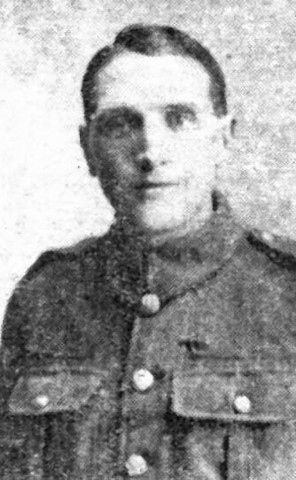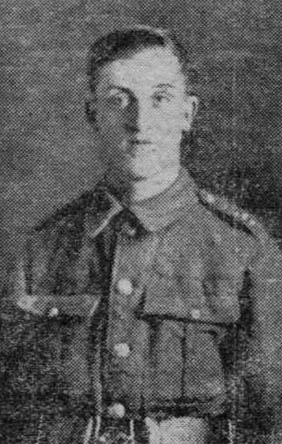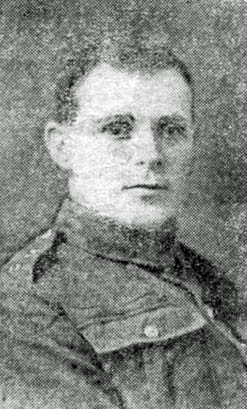Littleborough Soldiers who fell during September 1918
Date published: 03 September 2018

Driver John William Matthews
Driver John William Matthews
John William was born in Shrewsbury in 1890 and when aged 21 was lodging with Annie and John Hill at 2 Deanhurst Fold, Littleborough. He was a Labourer in a Calico Print Works, likely Clough Dye Works where he worked prior to enlisting in Rochdale.
27-year-old Driver 229237 John William Matthews, “D” Bty 189th Brigade, Royal Field Artillery, husband of Mrs Sarah Ann Matthews, 13 West Street, Durn, died from wounds on Sunday 1 September 1918, in a casualty clearing station in France and is buried in Grave Number III D 17 Ligny-St-Flochel British Cemetery, Averdoingt, France.
His name is inscribed on Littleborough Cenotaph and the Littleborough Conservative Club War Memorial and there is a J W Matthews listed on St John’s War Memorial at Smallbridge.
The Roll of Honour in the Rochdale Observer for 21 September 1918 included sentiments from all at 121 Croft Bank, Calderbrook Road, Littleborough.
Private (Frances) Herbert Maynard
Herbert was born in Littleborough in 1896 and in 1911 was employed as a butcher’s errand boy. He lived with his parents Frances John & Elizabeth at 35 Whitelees Road and attended Littleborough Central School.
Private Maynard was originally recorded as wounded in August 1918 but unfortunately it wasn’t until October that the official list included him as “killed.”
22-year-old Private 77745 Herbert Maynard 2nd Bn Royal Welsh Fusiliers was killed in action in France on Sunday 1 September 1918, being remembered on Panel 6 of the Vis-En-Artois Memorial, France and Littleborough Cenotaph as well as St Barnabas Church and Littleborough Central School War Memorial (now relocated in Littleborough’s History Centre) and also on the family grave in St James Churchyard.
Private John Ormandy

John was born in Smithy Bridge in 1893 and in 1901 he lived with his parents John and Ellen, his 3 sisters and two brothers at 4 Bamford’s Place, Smithy Bridge.
By 1911, the family had moved to 20 New Road: by then only Harold and Stella and John remained in the family home.
John was a bobbin carrier in a winding room and was at one time a member of Littleborough Parish Church choir.
Prior to enlisting in September 1915, John lived at 7 Rawlinson Street and was employed by Fothergill and Harveys.
Private Ormandy was part of the Mediterranean Expeditionary Force in Egypt but, in February 1917, he left Alexandria for France with his ship H.M.T. Megantic, luckily avoiding being sunk during a torpedo attack.
During autumn 1917, Private John Ormandy, 241759, 1st/6th Bn Lancashire Fusiliers was severely wounded whilst serving in Belgium.
First news of Private Ormandy being wounded was by a letter from the Rev. C. C. stating that Private Ormandy, “had been admitted to hospital seriously wounded.”
John himself later wrote that, “although suffering pain…. I do hope I may get home to England soon. I fear my fighting days are over for a long time to come.”
Private Ormandy was invalided home to a hospital near Sheffield from which the chaplain the Rev. E. P. Blakeney wrote from saying, “Private John Ormandy is suffering from a severe gunshot wound in the right shoulder and elbow, and underwent rather a serious operation last Thursday (date unknown) I am glad to say he is going on very well, but not yet out of danger ….”
Although numerous letters were sent advising on how much John’s condition was improving, on May 2 September 1918, when only 25 years old, he died as a result of the wounds he had received nearly twelve months previously, his mother Mrs Ellen Ormandy at his bedside.
On the 7 September 1918, he was accorded at military funeral, the Rev. G. Oakley conducting the service in St Andrew’s Church. His body lies in grave number M18 in Littleborough (Dearnley) Cemetery.
A memorial service was later held in his memory. Private Ormandy is remembered on Littleborough Cenotaph and on St Andrew’s Memorial Card and War Memorial.
Private James Arthur Stott

James was the Littleborough born (1891) son of Charles and Ada Stott who lived at 9 Higher Calderbrook.
In 1911, James was employed as a cotton operative and before enlistment in July 1916 was employed at Messrs Kershaw’s Wellfield Mill. He went to France in December 1916, but in August 1917, was wounded near Ypres, suffering shrapnel wounds in the right shoulder and over the right eye.
He came back to Tooting Military Hospital, London for treatment, which was successful, for he returned to France.
In August 1918, the 2nd Bn of the Lancashire Fusiliers were in trenches and undertook attacks around L'Ecleme, NW of Gonnehem.
26-year-old Private 34967 James Arthur Stott 2nd Bn Lancashire Fusiliers may have been injured in that attack as he died of wounds in a Casualty Clearing Station based in Ligny-St-Flochel, France on Thursday 3 September 1918.
He is interred in Ligny, St Flochel British Cemetery, his name is on the family grave in St James Churchyard, the headstone with the sentiment ‘THE SUPREME SACRIFICE - HIS LIFE’ and also on Littleborough Cenotaph.
The Rochdale Observer for 2 October 1918 reported that James Arthur Stott (26) of the Lancashire Fusiliers whose home was at 2 Lower Calderbrook, Littleborough was dangerously wounded on 2 September and died on the following day at a CCS abroad.
Rifleman George William Beswicke (Beswick)

George William was born in Oldham in 1893 and later lived with his uncle, Mr H F Greenwood and attended Littleborough Central School.
The casualty returns in the Rochdale Times included 25-year-old George W. Beswicke of 195 Centre Vale, Littleborough, killed in France in 1918.
The Rochdale Observer for 9 October 1918 added that he was son of Mr and Mrs Joe Beswick.
Rifleman 12929 Willie Beswick, 1st Batt, Kings Royal Rifle Corps was killed in action on Thursday 5 September 1918 whilst his regiment was in the Hindenburg Line, near Demicourt, west of the Canal du Nord.
Apparently, he was killed by a sniper. He is remembered on Panel 9, Vis-En-Artois Memorial, France and on Littleborough Cenotaph.
2nd Lieutenant Robert Lester Taylor
Robert was born in 1893 in Beverley, East Riding of Yorkshire, the son of Philip, a Wesleyan Minister and his mother Rosa.
In 1901 his parents were living in living in Bridlington and ten years later, aged 18, he was a pupil at Lansdown, Bath.
Prior to enlisting 2nd/Lieut Taylor was a scholar of Kingswood School, Bath, and B.A. Manchester University. His parents later were recorded as living at 11 Norwood Grove, Liverpool.
Second Lieutenant Robert Lester Taylor, 1st Garrison Batt, attached 11th Batt Somerset Light Infantry, Worcestershire Regiment died of wounds on Wednesday 11 September 1918, and is buried in Grave Number IV D 27 Aire Communal Cemetery, France.
The Rochdale Observer for 18 September 1918 recorded 2nd Lt R Lester Taylor, son of Rev P H Taylor, formerly Littleborough and later of Heywood.
Private Arthur Salt

Arthur was born in Dearnley, Littleborough in 1899 and two years later was living with his parents, Harry and Alice, and family at 3 School St, Dearnley.
Ten years later the family had moved to 1 New Road.
Prior to enlisting at Bury, Private Salt was a formerly in St. Andrew’s choir and worked at Messrs Foxcroft & Son, Whitelees.
Private Salt embarked at Folkestone on 1 August 1918 and reached Hubersent, France, where they trained until 20 August before going to the front line. His parents had moved to 68 New Road, Dearnley, where they lived at the time that their 19-year-old son Private 52090 Arthur Salt 6th Bn Somerset Light Infantry was killed in action in France on 12 September 1918.
On 22 August, they were in the trenches in the Cambrin sector, just south of the La Bassee Canal. During September 2010, two small attacks made by 6th Somerset’s and the 18th Gloucester’s, they captured the Brickstacks and the Railway Triangle in the first and La Brique and Auchy-les-La Bassee in the sec4th Qtr.
Private Salt is buried in Grave Number VII. E. 20. St. Mary’s A.D.S. Cemetery, Haisnes, France and is remembered on Littleborough Cenotaph and on the family grave in St Andrew's Churchyard.
A letter written by Private Salt’s Bn chaplain (Rev E M M Bright) said: “Private Salt was killed on the 12th September while his company was occupying new ground won by our boys from the Germans. He was killed instantaneously by a shell …..l. Owing to the difficulties of the engagement it was impossible to bring his body back to a cemetery and it was necessary for his comrades to bury him in the forward line. Please convey my very sincere sympathies to all members of his family.”
His death was recorded in the St Andrew's Magazine for October 1918 and the Rochdale Observer for 26 October 1918 reported, “Memorial Service – A service in memory of Private A Daniels, Lancashire Fusiliers and Private A Salt, Somerset Light Infantry was conducted in St Andrew’s Church, Dearnley, on Sunday by the Rev G R Oakley.”
Private Harold Conway
Harold was born in Littleborough in 1891 4th Qtr to parents Robert (46 a Shoe Maker) and Sarah Emma (38) but by 1901, the family had moved to 120, Stockport Road Hyde, Cheshire.
Harold later enlisted in Ashton-Under-Lyne but on Wednesday 18 September 1918, 26-year-old Private 50380, Harold Conway, 12th Bn (Duke of Lancaster’s Own Yeomanry) Manchester Regiment, died of wounds in a casualty clearing station.
He was buried in Grave Number C 16 Five Points Cemetery, Lechelle, France.
Private Harry Howard
Harry was born in Littleborough in 1876. In 1881, he was living with his grandparents, Abraham (a farmer of three acres) and Betty Howard at High Lee.
Also living there were two uncles and an aunt together with his own parents, Thomas and Alice, as well as his brothers and sisters.
By 1891, Harry’s close family had left their parents’ house and moved to 13 West Street.
Harry was a flannel raiser and his father a flannel finisher.
Harry married Alice during 1899 (3rd Qtr) and in 1901 they lived at 5 Rawlinson Street and both worked as weavers in cotton mills.
By 1911, Harry and Alice, together with eight-year-old Clara (born 1903) lived at 8 Moorland Street, Littleborough.
On Saturday 21 September 1918, 41-year-old Private 242425 Harry Howard, 1st/5th Bn, Lancashire Fusiliers, died in a German prisoner of war camp.
His body is interred in Grave Number XI G 5 at Cologne Southern Cemetery, Koln (Cologne) Nordrhein-Westfalen, Germany and is remembered on the Holy Trinity Church War Memorial and Littleborough Cenotaph.
His wife, Mrs Alice A Howard, later lived at 14 Barehill Street.
Private Abraham Daniels

Abraham was born in Littleborough in 1890 and in 1891 was living at 15 Sale Street with parents, William (32, a Hosiery Manufacturer Manager) and Margaret (33) and brothers and sister.
The family lived at 3 Drydock (New Road), Dearnley in 1901 but by 1911 the family had moved to 20 Stratford Ave., Castleton.
By now, his father was an Insurance Superintendent and Abraham was a twine maker.
Having enlisted in Rochdale, Private Daniels subsequently moved to France but unfortunately during the fighting was dangerously wounded in the head and leg sustained in a gas attack.
28-year-old Private Daniels 204146 2/5th Bn Lancashire Fusiliers died of wounds in hospital on 23 September 1918 probably received in the Givenchy Area and is buried in grave No III D 8 in Houchin British Cemetery, France.
He is remembered on the St Andrew’s Church War Memorial.
The St Andrew’s Magazine for October 1918 included, “We are very sorry indeed to hear that Abraham Daniels has been dangerously wounded in France. The chaplain of the hospital in which he is says ‘his case is not hopeless’ but the wounds ….. are very serious. We hope earnestly of better news.”
It later added, “Just as we send this to the printer we learn with much sorrow that Abraham Daniels died from his wounds….”
The Rochdale Observer for 26 October 1918 reported: “Memorial Service – A service in memory of Private A Daniels, Lancashire Fusiliers and Private A Salt, Somerset Light Infantry was conducted in St Andrew’s Church, Dearnley, on Sunday by the Rev G R Oakley.”
Private James Albert Beresford

James was born in Littleborough on 18 November 1892, and in 1901 he was living at 9 Railway Street with his mother, Ann, and father, William, a coal miner, his five sisters and two brothers.
By 1911 his father, now a widower, had retired and had moved with his family of two daughters and two sons to 4 Woodbine Passage, Littleborough.
James married Alice Stott at Smithy Bridge Union Methodist Chapel on 10 April 1915 and showed his address as 95 Smithy Bridge Road.
Before he enlisted on 8 December 1915, he worked for Drydock Mill, Dearnley.
He was recorded as entering the Army Reserve on 9 December 1915, being mobilised on 19 July 1916 with his Army Service counted from 26 July 1916.
He left for France arriving there on 11 January 1917, but he was gassed later that year.
On 21 September 1918 he was again gassed and moved to 15 CCS where 26-year-old Private 203838 J. A. Beresford, 2nd/5th Bn Lancashire Fusiliers died of gas poisoning on Wednesday 25 September 1918.
His battalion was the 2nd/5th Bn from the 24 until the 1 October in outpost line, Givenchy.
He was buried in Grave No III D 18 Houchin British Cemetery, France and is remembered on Littleborough Cenotaph and the Littleborough Central School Memorial.
Later correspondence shows his widow living at 6 Elm St, Smithy Bridge.
Gunner Fred Leach

Born in Littleborough in 1892, he was the son of Robert H and Sarah A, who in 1901 lived at 8 East Street, Littleborough.
His father was a cotton power loom overlooker. His widowed mother and three sisters later moved to lived 6 Warren St.
The Rochdale Observer of 22 March 1918 reported that Gunner Leach was admitted to a Scottish Hospital suffering from gas shell wounds, aged 23, and was formerly employed on the Rochdale Corporation Tramcars.
Gunner Leach 58621, of 110 Bde Royal Field Artillery (enlisted Bury) was 26 years old when he was killed in France on 25 September 1918. He is buried in grave No IV F 19 in Peronne Communal Cemetery Extension in France.
His name is recorded on St Barnabas War Memorial, Shore.
Private Edmund Maden
Edmund was born in Britannia, Bacup in 1896 and was still living there at the time of the 1911 census, being employed as a cotton doffer.
He enlisted in Rochdale but later 22-year-old Private 203831 Edmund Maden, 2nd/4th Bn East Yorkshire Regiment died on Thursday 26 September 1918, being interred in Grave Number 852 Prospect Hill Cemetery, Bermuda.
He was the son of Mr Edmund and Mrs Hannah Maden, 3 Railway Street, Littleborough and his name is inscribed on Littleborough Cenotaph.
Rifleman Clement Firth
Clement was born in Halifax in 1899: in 1901 the family were living at 3 Booth’s Yard.
By 1911, Clement lived at 20 Box Street, Littleborough with his father Jose, a boot and shoe maker, his mother Alice, four brothers and a sister.
At the time of enlistment, he still lived at that address but by now was employed as a clerk by the Sladen Wood Mill Company, Summit, Littleborough.
During 1916 the Rochdale Observer reported that he was ordered to pay the costs for riding a bicycle without a red light to the rear.
A little over two years later, 19-year-old Rifleman R/38320 Clement Firth, 1st Bn Kings Royal Rifle Corps died from wounds on 30 September 1918.
He is buried in Grave Number XIV. D. 15, Grevillers British Cemetery, Pas de Calais, France.
The 1st Battalion Kings Royal Rifle Corps were involved in the Battle of the Canal du Nord. 27 Sep-1 Oct 1918 (part of the Hundred Days Offensive), the 1KRRC started from west of Canal Du Nord (27th Sept) and crossed over to Flesquieres.
They attacked from the (Sugar) Beet Factory at Flesquires towards Marcoing (on 28th Sept) via Premy Chapel & Nine Wood and onto Noyelles and Canal, later on 29th attacks around Marcoing Switch and Support lines, Flot Farm and Mt sur l' CEuvre.
Although it is unclear when Rifleman Firth was injured it is likely to have been during these 2-3 days of attacks.
Rifleman Firth’s name is remembered on the Holy Trinity Church War Memorial and Littleborough Cenotaph.
A newspaper item on casualties in the Rochdale Observer of 12 October 1918 gave the following:- LITTLEBOROUGH SIGNALLER KILLED:- Official information has been received that Signaller Clement Firth (1st Bn King’s Royal Rifle Corps), died from gun-shot wounds causing a fracture of the skull, on 30th September 1918.
Do you have a story for us?
Let us know by emailing news@rochdaleonline.co.uk
All contact will be treated in confidence.
Most Viewed News Stories
- 1Newhey's Char Steakhouse and Bank Chamber close with immediate effect
- 2Failing care home shut by health watchdog following safety concerns
- 3Man charged in connection with assault on Christmas Eve in Sudden
- 4Two men arrested after police chase ends up in Middleton river
- 5Woman of Rochdale 2024 – Lorenza Pye
To contact the Rochdale Online news desk, email news@rochdaleonline.co.uk or visit our news submission page.
To get the latest news on your desktop or mobile, follow Rochdale Online on Twitter and Facebook.


